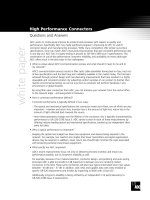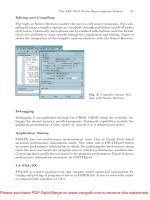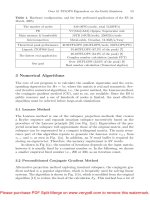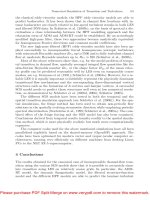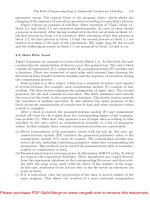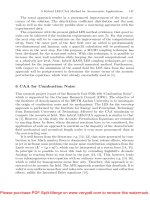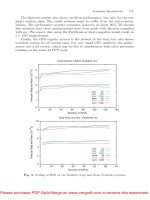Tài liệu High Performance Computing on Vector Systems-P1 pdf
Bạn đang xem bản rút gọn của tài liệu. Xem và tải ngay bản đầy đủ của tài liệu tại đây (641.08 KB, 30 trang )
Resch · Bönisch · Benkert · Furui · Seo · Bez (Eds.)
High Performance Computing on Vector Systems
Please purchase PDF Split-Merge on www.verypdf.com to remove this watermark.
Michael Resch · Thomas Bönisch · Katharina Benkert
Toshiyuki Furui · Yoshiki Seo · Wolfgang Bez
Editors
High Performance
Computing
on Vector Systems
Proceedings of the High Performance Computing Center
Stuttgart, March 2005
With128Figures,81inColor,and31Tables
123
Please purchase PDF Split-Merge on www.verypdf.com to remove this watermark.
Editors
Michael Resch
Thomas Bönisch
Katharina Benkert
Höchstleistungsrechenzentrum
Stuttgart (HLRS)
Universität Stuttgart
Nobelstraße 19
70569 Stuttgart, Germany
Wolf gang B e z
NEC High Performance
Europe GmbH
Prinzenallee 11
40459 Düsseldorf, Germany
Toshiyuki Furui
NEC Corporation
Nisshin-cho 1-10
183-8501 Tokyo, Japan
Yoshiki Seo
NEC Corporation
Shimonumabe 1753
211-8666 Kanagawa, Japan
Front cover figure: Image of two dimensional magnetohydrodynamics simulation where current
density has decayed from an Orszag-Tang vortex to form cross-like structures
Library of Congress Control Number: 2006924568
Mathematics Subject Classification (2000): 65-06, 68U20, 65C20
ISBN-10 3-540-29124-5 Springer Berlin Heidelberg New York
ISBN-13 978-3-540-29124-4 Springer Berlin Heidelberg New York
This work is subject to copyright. All rights are reserved, whether the whole or part of the material
is concerned, specifically the rights of translation, reprinting, reuse of illustrations, recitation, broad-
casting, reproduction on microfilm or in any other way, and storage in data banks. Duplication of
this publication or parts thereof is permitted only under the provisions of the German Copyright Law
of September 9, 1965, in its current version, and permission for use must always be obtained from
Springer. Violations are liable for prosecution under the German Copyright Law.
Springer is a part of Springer Science+Business Media
springer.com
© Springer-Verlag Berlin Heidelberg 2006
Printed in Germany
The use of general descriptive names, registered names, trademarks, etc. in this publication does not
imply, even in the absence of a specific statement, that such names are exempt from the relevant pro-
tective laws and regulations and therefore free for general use.
Typeset by the editors using a Springer T
E
X macro package
Production and data conversion: LE-T
E
XJelonek,Schmidt&VöcklerGbR,Leipzig
Cover design: design & production GmbH, Heidelberg
Printed on acid-free paper 46/3142/YL - 5 4 3 2 1 0
Please purchase PDF Split-Merge on www.verypdf.com to remove this watermark.
Preface
In March 2005 about 40 scientists from Europe, Japan and the US came together
the second time to discuss ways to achieve sustained performance on supercom-
puters in the range of Teraflops. The workshop held at the High Performance
Computing Center Stuttgart (HLRS) was the second of this kind. The first one
had been held in May 2004. At both workshops hardware and software issues
were presented and applications were discussed that have the potential to scale
and achieve a very high level of sustained performance.
The workshops are part of a collaboration formed to bring to life a concept
that was developed in 2000 at HLRS and called the “Teraflop Workbench”. The
purpose of the collaboration into which HLRS and NEC entered in 2004 was to
turn this concept into a real tool for scientists and engineers. Two main goals
were set out by both partners:
• To show for a variety of applications from different fields that a sustained
level of performance in the range of several Teraflops is possible.
• To show that different platforms (vector based systems, cluster systems) can
be coupled to create a hybrid supercomputer system from which applications
can harness an even higher level of sustained performance.
In 2004 both partners signed an agreement for the “Teraflop Workbench
Project” that provides hardware and software resources worth about 6 MEuro
(about 7 Million $ US) to users and in addition provides the funding for 6 scien-
tists for 5 years. These scientists are working together with application develop-
ers and users to tune their applications. Furthermore, this working group looks
into existing algorithms in order to identify bottlenecks with respect to modern
architectures. Wherever necessary these algorithms are improved, optimized, or
even new algorithms are developed.
The Teraflop Workbench Project is unique in three ways:
First, the project does not look at a specific architecture. The partners have
accepted that there is not a single architecture that is able to provide an out-
standing price/performance ratio. Therefore, the Teraflop Workbench is a hybrid
architecture. It is mainly composed of three hardware components
Please purchase PDF Split-Merge on www.verypdf.com to remove this watermark.
VI Preface
• A large vector supercomputer system. The NEC SX-8/576M72 has 72 nodes
and 576 vector processors. Each processor has a peak performance of 22
GFLOP/s which results in a peak overall performance of the system of 12.67
TFLOP/s. The sustained performance is about 9 TFLOP/s for Linpack and
about 3–6 TFLOP/s for applications. Some of the results are shown in this
book. The system is equipped with 9.2 TB of main memory and hence allows
to run very large simulation cases.
• A large cluster of PCs. The 200 node system comes with 2 processors per
node and a total peak performance of about 2.4 TFLOP/s. The system is
perfectly suitable for a variety of applications in physics and chemistry.
• Two shared memory front end systems for offloading development work but
also for providing large shared memory for pre-processing jobs. The two sys-
tems are equipped with 32 Itanium (Madison) processors and provide a peak
performance of about 0.19 TFLOP/s each. They come with 0.256 TB and
0.512 TB of shared memory respectively which should be large enough even
for larger pre-processing jobs. They are furthermore used for applications
that rely on large shared memory such as some of the ISV codes used in
automobile industry.
Second, the collaboration takes an unconventional approach towards data
management. While mostly the focus is on management of data the Teraflop
Workbench Project considers data to be the central issue in the whole simulation
workflow. Hence, a file system is at the core of the whole workbench. All three
hardware architectures connect directly to this file system. Ideally the user only
once has to transfer basic input information from his desk to the workbench.
After that data reside inside the central file system and are only modified either
for pre-processing, simulation or visualization.
Third, the Teraflop Workbench Project does not look at a single application
or a small number of well defined problems. Very often extreme fine-tuning is
employed to achieve some level of performance for a single application. This is
reasonable wherever a single application can be found that is of overwhelming
importance for a centre. For a general purpose supercomputing centre like the
HLRS this is not possible. The Teraflop Workbench Project therefore sets out to
tackle as many fields and as many applications as possible. This is also reflected in
the contents of this book. The reader will find a variety of application fields that
range from astrophysics to industrial combustion processes and from molecular
dynamics to turbulent flows. In total the project supports about 20 projects of
which most are presented here.
In the following the book presents key contributions about architectures and
software but many more papers were collected that describe how applications
can benefit from the architecture of the Teraflop Workbench Project. Typically
sustained performance levels are given although the algorithms and the concrete
problems of every field still are at the core of each contribution.
As an opening paper NEC provides a scientifically very interesting technical
contribution about the most recent system of the NEC SX family the SX-8. All
of the projects described in this book either use the SX-8 system of HLRS as
Please purchase PDF Split-Merge on www.verypdf.com to remove this watermark.
Preface VII
the simulation facility or provide comparisons of applications on the SX-8 and
other systems. The paper can hence be seen as an introduction of the underlying
hardware that is used by various projects.
In their paper about vector processors and micro processors Peter Lammers
from the HLRS, Gerhard Wellein, Thomas Zeiser, and Georg Hager from the
Computing Centre, and Michael Breuer from the chair for fluid mechanics at
the University of Erlangen, Germany, look at two competing basic processor
architectures from an application point of view. The authors compare the NEC
SX-8 system with the SGI Altix architecture. The comparison is not only about
the processor but involves the overall architecture. Results are presented for
two applications that are developed at the department of fluid mechanics. One
is a finite volume based direct numerical simulation code while the other is
based on the Lattice Boltzmann method and is again used in direct numerical
simulation. Both codes rely heavily on memory bandwidth and as expected the
vector system provides superior performance. Two points are, however, very
notable. First, the absolute performance for both codes is rather high with one
of them reaching even 6 TFLOP/s. Second, the performance advantage of the
vector based system has to be put into relation with the costs which gives an
interesting result.
A similar but more extensive comparison of architectures can be found in the
next contribution. Jonathan Carter and Leonid Oliker from Lawrence Berkeley
National Laboratory, USA have done a lot of work in the field of architecture
evaluation. In their paper they describe recent results on the evaluation of mod-
ern parallel vector architectures like the Cray X1, the Earth Simulator and the
NEC SX-8 and compare them to state of the art microprocessors like the Intel
Itanium the AMD Opteron and the IBM Power processor. For their simulation of
magnetohydrodynamics they also use a Lattice Boltzmann based method. Again
it is not surprising that vector systems outperform microprocessors in single pro-
cessor performance. What is striking is the large difference which combined with
cost arguments changes the picture dramatically.
Together these first three papers give an impression of what the situation
in supercomputing currently is with respect to hardware architectures and with
respect to the level of performance that can be expected. What follows are three
contributions that discuss general issues in simulation – one is about sparse
matrix treatment, a second is about first-principles simulation while the third
tackles the problem of transition and turbulence in wall-bounded shear flow. All
three problems are of extreme importance for simulation and require a huge level
of performance.
Toshiyuki Imamura from the University of Electro-Communications in Tokyo,
Susumu Yamada from the Japan Atomic Energy Research Institute (JAERI) in
Tokyo, and Masahiko Machida from Core Research for Evolutional Science and
Technology (CREST) in Saitama, Japan tackle the problem of condensation of
fermions to investigate the possibility of special physical properties like super-
fluidity. They employ a trapped Hubbard model and end up with a large sparse
matrix. By introducing a new preconditioned conjugate gradient method they
Please purchase PDF Split-Merge on www.verypdf.com to remove this watermark.
VIII Preface
are able to improve the performance over traditional Lanzcos algorithms by
a factor of 1.5. In turn they are able to achieve a sustained performance of 16.14
TFLOP/s on the earth simulator solving a 120-billion-dimensional matrix.
In a very interesting and well founded paper Yoshiyuki Miyamoto from the
Fundamental and Environmental research Laboratories of NEC Corporation de-
scribes simulations of ultra-fast phenomena in carbon nanotubes. The author
employs a new approach based on the time-dependent densitiy functional theory
(TDDFT), where the real-time propagation of the Kohn-Sham wave functions
of electrons are treated by integrating the time-evolution parameter. This tech-
nique is combined with a classical molecular dynamics simulation in order to
make visible very fast phenomena in condensed matters.
With Philipp Schlatter, Steffen Stolz, and Leonhard Kleiser from the ETH
Z¨urich, Switzerland we again change subject and focus even more on the appli-
cation side. The authors give an overview of numerical simulation of transition
and turbulence in wall-bounded shear flows. This is one of the most challenging
problems for simulation requiring a level of performance that is currently be-
yond our reach. The authors describe the state of the art in the field and discuss
Large Eddy Simulation (LES) and Subgrid-Scale models (SGS) and their usage
for direct numerical simulation.
The following papers present projects tackled as part of the Teraflop Work-
bench Project.
Malte Neumann and Ekkehard Ramm from the Institute of Structural Me-
chanics in Stuttgart, Germany, Ulrich K¨uttler and Wolfgang A. Wall from the
Chair for Computational Mechanics in Munich, Germany, and Sunil Reddy
Tiyyagura from the HLRS present findings for the computational efficiency of
parallel unstructured finite element simulations. The paper tackles some of the
problems that come with unstructured meshes. An optimized method for the
finite element integration is presented. It is interesting to see that the authors
have employed methods to increase the performance of the code on vector sys-
tems and can show that also microprocessor architectures can benefit from these
optimizations. This supports previous findings that cache optimized program-
ming and vector processor optimized programming very often lead to similar
results.
The role of supercomputing in industrial combustion modeling is described
in an industrial paper by Natalia-Currle Linde, Uwe K¨uster, Michael Resch, and
Benedetto Risio which is a collaboration of HLRS and RECOM Services – a small
enterprise at Stuttgart, Germany. The quality of simulation in the optimum de-
sign and steering of high performance furnaces of power plants has reached a level
at which it can compete with physical experiments. Such simulations require not
only an extremely high level of performance but also the ability to do parame-
ter studies. In order to relieve the user from the burden of submitting a set of
jobs the authors have developed a framework that supports the user. The Sci-
ence Experimental Grid Laboratory (SEGL) allows to define complex workflows
which can be executed in a Grid environment like the Teraflop Workbench. It
Please purchase PDF Split-Merge on www.verypdf.com to remove this watermark.
Preface IX
furthermore supports the dynamic generation of parameter sets which is crucial
for optimization.
Helicopter simulations are presented by Thorsten Schwarz, Walid Khier, and
Jochen Raddatz from the Institute of Aerodynamics and Flow Technology of the
German Aerospace Center (DLR) at Braunschweig, Germany. The authors use
a structured Reynolds-averaged Navier-Stokes solver to compute the flow field
around a complete helicopter. Performance results are given both for the NEC
SX-6 and the new NEC SX-8 architecture.
Hybrid simulations of aeroacoustics are described by Qinyin Zhang, Phong
Bui, Wageeh A. El-Askary, Matthias Meinke, and Wolfgang Schr¨oder from the
Department of Aerodynamics of the RWTH Aachen, Germany. Aeroacoustics
is a field that is getting important for aerospace industries. Modern engines of
airplanes are so silent that the noise created from aeroacoustic turbulences has
often become a more critical source of sound. The simulation of such phenomena
is split into two parts. In a first part the acoustic source regions are resolved
using a large eddy simulation method. In the second step the acoustic field is
computed on a coarser grid. First results of the coupled approach are presented
for relatively simple geometries. Simulations are carried out on 10 processors but
will require much higher performance for more complex problems.
Albert Ruprecht from the Institute of Fluid Mechanics and Hydraulic Ma-
chinery of the University of Stuttgart, Germany, shows simulation of a water
turbine. The optimization of these turbines is crucial to extract the potential
of water power plants when producing electricity. The author uses a parallel
Navier-Stokes solver and provides some interesting results.
A topic that is unusual for vector architectures is atomistic simulation. Franz
G¨ahler from the Institute of Theoretical and Applied Sciences of the University
of Stuttgart, Germany, and Katharina Benkert from the HLRS describe a com-
parisonofanabinitiocodeandaclassicalmoleculardynamicscodefordifferent
hardware architectures. It turns out that the ab initio simulations perform ex-
cellently on vector machines. Again it is, however, worth to look at the ratio
of performance on vector and microprocessor systems. The molecular dynamics
code in its existing version is better suited for large clusters of microprocessor
systems. In their contribution the authors describe how they want to improve
the code to increase the performance also for vector based systems.
Martin Bernreuther from the Institute of Parallel and Distributed Systems
and Jadran Vrabec from the Institute of Thermodynamics and Thermal Process
Engineering of the University of Stuttgart, Germany, in their paper tackle the
problem of molecular simulation of fluids with short range potentials. The au-
thors develop a simulation framework for molecular dynamics simulations that
specifically targets the field of thermodynamics and process engineering. The
concept of the framework is described in detail together with algorithmic and
parallelization aspects. Some first results for a smaller cluster are shown.
An unusual application for vector based systems is astrophysics. Konstantinos
Kifonidis, Robert Buras, Andreas Marek, and Thomas Janka from the Max-
Planck-Institute for Astrophysics at Garching, Germany, give an overview of
Please purchase PDF Split-Merge on www.verypdf.com to remove this watermark.
X Preface
the problems and the current status of supernova modeling. Furthermore they
describe their own code development with a focus on the aspects of neutrino
transports. First benchmark results are reported for an SGI Altix system as well
as for the NEC SX-8. The performance results are interesting but so far only
a small number of processors is used.
With the next paper we return to classical computational fluid dynamics.
Kamen N. Beronov, Franz Durst, and Nagihan
¨
Ozyilmaz from the Chair for
Fluid Mechanics of the University of Erlangen, Germany, together with Peter
Lammers from HLRS present a study on wall-bounded flows. The authors first
present the state of the art in the field and compare different approaches. They
then argue for a Lattice Boltzmann approach providing also first performance
results.
A further and last example in the same field is described in the paper of An-
dreas Babucke, Jens Linn, Markus Kloker, and Ulrich Rist from the Institute of
Aerodynamics and Gasdynamics of the University of Stuttgart, Germany. A new
code for direct numerical simulations solving the complete compressible 3-D
Navier-Stokes equations is presented. For the parallelization a hybrid approach
is chosen reflecting the hybrid nature of clusters of shared memory machines like
the NEC SX-8 but also multiprocessor node clusters. First performance mea-
surements show a sustained performance of about 60% on 40 processors of the
SX-8. Further improvements of scalability have to be expected.
The papers presented in this book provide on the one hand a state of the
art in hardware architecture and performance benchmarking. They furthermore
lay out the wide range of fields in which sustained performance can be achieved
if appropriate algorithms and excellent programming skills are put together. As
the first of books in this series to describe the Teraflop Workbench Project the
collection provides a lot of papers presenting new approaches and strategies to
achieve high sustained performance. In the next volume we will see many more
results and further improvements.
Stuttgart, January 2006 M. Resch
W. Bez
Please purchase PDF Split-Merge on www.verypdf.com to remove this watermark.
Contents
Future Architectures in Supercomputing
The NEC SX-8 Vector Supercomputer System
S. Tagaya, M. Nishida, T. Hagiwara, T. Yanagawa, Y. Yokoya,
H. Takahara, J. Stadler, M. Galle, and W. Bez ........................ 3
Have the Vectors the Continuing Ability to Parry the Attack
of the Killer Micros?
P. Lammers, G. Wellein, T. Zeiser, G. Hager, and M. Breuer ........... 25
Performance and Applications on Vector Systems
Performance Evaluation of Lattice-Boltzmann Magnetohydrodynamics
Simulations on Modern Parallel Vector Systems
J. Carter and L. Oliker ............................................. 41
Over 10 TFLOPS Computation for a Huge Sparse Eigensolver
on the Earth Simulator
T. Imamura, S. Yamada, and M. Machida ............................ 51
First-Principles Simulation on Femtosecond Dynamics
in Condensed Matters Within TDDFT-MD Approach
Y. Miyamoto ...................................................... 63
Numerical Simulation of Transition and Turbulence
in Wall-Bounded Shear Flow
P. Schlatter, S. Stolz, and L. Kleiser ................................. 77
Please purchase PDF Split-Merge on www.verypdf.com to remove this watermark.
XII Contents
Applications I: Finite Element Method
Computational Efficiency of Parallel
Unstructured Finite Element Simulations
M. Neumann, U. K¨uttler, S.R. Tiyyagura, W.A. Wall, and E. Ramm ..... 89
The Role of Supercomputing in Industrial Combustion Modeling
N. Currle-Linde, B. Risio, U. K¨uster, and M. Resch ...................109
Applications II: Fluid Dynamics
Simulation of the Unsteady Flow Field
Around a Complete Helicopter with a Structured RANS Solver
T. Schwarz, W. Khier, and J. Raddatz ................................125
A Hybrid LES/CAA Method for Aeroacoustic Applications
Q. Zhang, P. Bui, W.A. El-Askary, M. Meinke, and W. Schr¨oder ........139
Simulation of Vortex Instabilities in Turbomachinery
A. Ruprecht .......................................................155
Applications III: Particle Methods
Atomistic Simulations on Scalar and Vector Computers
F. G¨ahler and K. Benkert ...........................................173
Molecular Simulation of Fluids with Short Range Potentials
M. Bernreuther and J. Vrabec .......................................187
Toward TFlop Simulations of Supernovae
K. Kifonidis, R. Buras, A. Marek, and T. Janka .......................197
Applications IV: Turbulence Simulation
Statistics and Intermittency of Developed Channel Flows:
a Grand Challenge in Turbulence Modeling and Simulation
K.N. Beronov, F. Durst, N.
¨
Ozyilmaz, and P. Lammers .................215
Direct Numerical Simulation of Shear Flow Phenomena
on Parallel Vector Computers
A. Babucke, J. Linn, M. Kloker, and U. Rist ..........................229
Please purchase PDF Split-Merge on www.verypdf.com to remove this watermark.
List of Contributors
Babucke, Andreas, 228
Benkert, Katharina, 173
Bernreuther, Martin, 186
Beronov, Kamen N., 215
Bez, Wolfgang, 3
Breuer, Michael, 25
Bui, Phong, 137
Buras, Robert, 195
Carter, Jonathan, 41
Currle-Linde, Natalia, 107
Durst, Franz, 215
El-Askary, Wageeh A., 137
G¨ahler, Franz, 173
Galle, Martin, 3
Hager, Georg, 25
Hagiwara, Takashi, 3
Imamura, Toshiyuki, 50
Janka, Thomas, 195
Khier, Walid, 125
Kifonidis, Konstantinos, 195
Kleiser, Leonhard, 77
Kloker, Markus, 228
K¨uster, Uwe, 107
K¨uttler, Ulrich, 89
Lammers, Peter, 25, 215
Linn, Jens, 228
Machida, Masahiko, 50
Marek, Andreas, 195
Meinke, Matthias, 137
Miyamoto, Yoshiyuki, 61
Neumann, Malte, 89
Nishida, Masato, 3
Oliker, Leonid, 41
¨
Ozyilmaz, Nagihan, 215
Raddatz, Jochen, 125
Ramm, Ekkehard, 89
Resch, Michael, 107
Risio, Benedetto, 107
Rist, Ulrich, 228
Ruprecht, Albert, 153
Schlatter, Philipp, 77
Schr¨oder, Wolfgang, 137
Schwarz, Thorsten, 125
Stadler, J¨org, 3
Stolz, Steffen, 77
Tagaya, Satoru, 3
Takahara, Hiroshi, 3
Tiyyagura, Sunil Reddy, 89
Vrabec, Jadran, 186
Wall, Wolfgang A., 89
Wellein, Gerhard, 25
Yamada, Susumu, 50
Yanagawa, Takashi, 3
Yokoya, Yuji, 3
Zeiser, Thomas, 25
Zhang, Qinyin, 137
Please purchase PDF Split-Merge on www.verypdf.com to remove this watermark.

